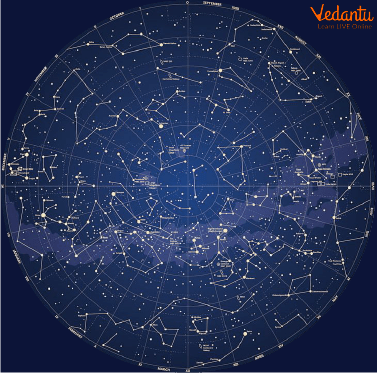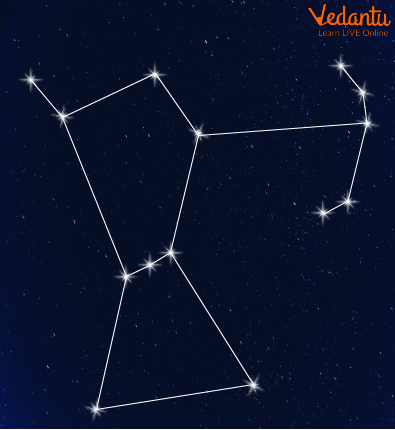




Introduction to Constellations
A star is created in space when various gases are united by the gravitational effect and by the fusion of hydrogen and helium atoms. Every star has a mass directly related to its gravity. This implies that the larger the star, the less time it will live (stars with a lot of mass use more fuel).
If the stars are hot, they tend towards a bluish colouration and if they are cooler, they tend towards red. When you look up at the sky and see a pattern then a question may arise in your brain, what are constellations. Let’s read below.
What are Constellations?
A constellation occurs when a group of stars is located in the sky in such a way that they produce an image. Keep in mind that the observation of the sky is different depending on the place of observation and the season of the year.
The contemplation of the stars has been carried out since ancient times. Thus, the Babylonians, the Egyptians, or the Greeks of the ancient world called constellations the groups of stars that they associated with some supernatural divinity. The Greeks named a large part of the constellations, especially those that are observed from the Northern Hemisphere.
How Many Constellations are There?
Now let us talk about how many constellations are there in the sky. Astronomers officially recognize 88 constellations that cover the entire sky in the Northern and Southern Hemispheres. Currently, 14 men and women, 9 birds, two insects, 19 land animals, 10 aquatic creatures, two centaurs, a scalp (Coma Berenices), a snake, a dragon, a flying horse, a river, and 29 inanimate objects, are represented in the night sky. It should be noted that the total number of constellations exceeds 88 because some constellations of stars include more than one creature.

The Constellations
It is important to realize that the vast majority of star patterns bear little or no resemblance to the figures they are supposed to represent and are named after. The ancient constellation builders probably intended them to be symbolic, not literal, representations of their favourite animals or legendary heroes, i.e. a kind of celestial "Hall of Fame".
Types of Constellation
Circumpolar Constellations
They can be seen in the Northern Hemisphere throughout the year, for example, Ursa Major, Ursa Minor, Giraffe, or Dragon.
Spring Constellations
It could be said that the sky expands and we can enjoy more galaxies during this time of year, such as Crater, Hydra, or Leo.
Summer Constellations
The earth is orbiting looking towards the interior of the Milky Way, therefore, we can enjoy: Swan, Arrow, or Horse constellations among others.
Autumn Constellations
Now the earth does not look towards the Milky Way but towards the interior of the dark universe. Thus, we will be able to see galaxies that are incredibly far away, such as Andromeda, Aquarius, or Pegasus.
Winter Constellations
The Milky Way is at the top of the sky at dusk and there are plenty of constellations to look out for, weather permitting, such as Coachman, Hare, or Gemini.
It should be noted that the constellations seen from the Northern Hemisphere are not the same as those seen from the Southern Hemisphere.
Orion Constellation
The most conspicuous example of a constellation is Orion which can be seen from anywhere on the Earth. This figure unites bright points of light forming the well-known "Belt of Orion", also called "The Three Wise Men" because there are three outstanding stars (Mintaka, Alnilam, and Alnitak).

Orion Constellation
This image complies with our terrestrial perspective since, if this constellation were seen from space, it would be possible to perceive that its stars move around due to their varying distances from the planet.
Orion's shape resembles that of an hourglass surmounted by two upper stars. It is best known in the entire sky and is located near the constellation of the river Eridanus and the constellation of Taurus.
The complex of clouds that make up Orion is a gigantic structure of hydrogen, dust, plasma, and nascent stars and in terms of its location, it is located at a distance of 1500 light-years from Earth.
Summary
A constellation is a collection of stars in the night sky that resembles a known object or design. They might take the form of humans, animals, or things. Numerous human-shaped designs bear the names of legendary characters from antiquity.
Numerous applications of constellations exist in astronomy, navigation, agriculture, and literature. In the sky, there are 88 main star constellations. You can't see them all at once, and some of them, particularly the brightest ones during the day, are almost hard to view without a telescope.
FAQs on Constellations for Kids
1. What is a constellation? What points should be considered before a sky watch?
The term "constellation" refers to a collection of stars that have a distinct shape. Examples of constellations include the Big Dipper and Orion.
Before performing a skywatch, it is important to keep the following things in mind:
The location should be as remote from the city as possible.
It is best to observe the night of the new moon.
For skywatching, binoculars or telescopes should be utilized.
For skywatching, the Pole Star should be used as a guide.
Start your skywatching with the stars in the west.
2. What are constellations used for?
Over the years, a constellation of stars has been used for a variety of reasons. Constellations have been used to:
Remind farmers to grow and harvest crops since they emerge in the sky at specified locations at various times of the year.
Guiding people across oceans and through deserts.
Used to symbolize characters from folklore such as heroes and legendary animals that have been the focus of stories for many years.
Additionally, there is a constellation that corresponds to each sign of the zodiac and follows the Earth's orbit around the sun as seen from the Northern Hemisphere. The ecliptic, or path of the orbit, is where the 12 constellations of the zodiac are located.









